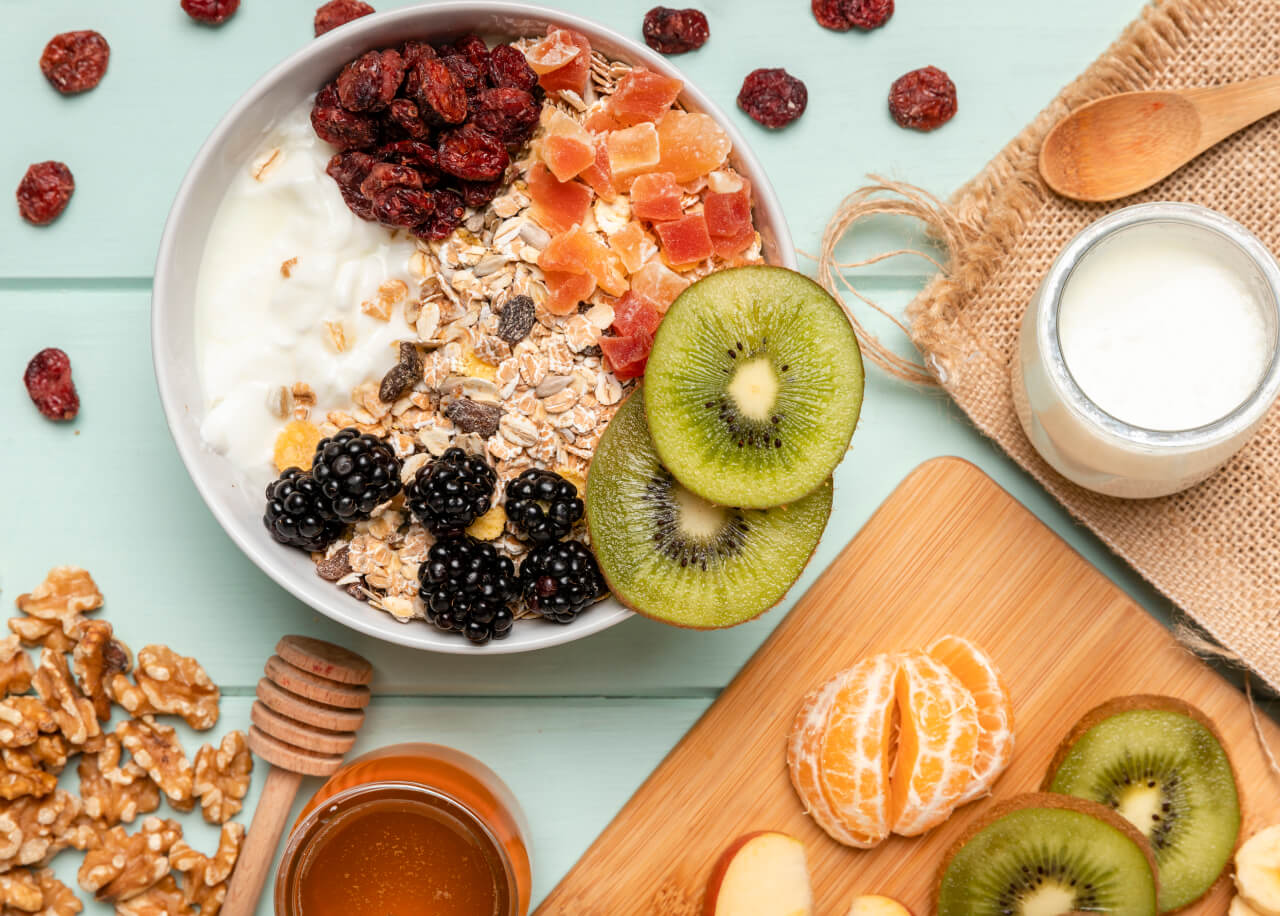The Complete Guide to Dietary Fiber

Introduction
Dietary fiber, often called roughage or bulk, is the part of plant-based foods your body cannot digest. While macronutrients like carbohydrates, proteins, and fats are essential for energy and body functions, fiber plays a unique and equally important role in maintaining optimal health. As more research has come to light about the significant impact of fiber on various aspects of health, it has gained increasing attention in both medical and nutritional circles.
In this guide, we’ll explore the different types of dietary fiber, how they work, the impressive benefits fiber offers, the potential side effects, and tips on how to incorporate fiber into your diet.
What is Dietary Fiber?
Dietary fiber consists of the indigestible parts of plant foods, which pass through the digestive system relatively intact, providing bulk to the stool and aiding in digestion. It’s primarily found in fruits, vegetables, whole grains, legumes, nuts, and seeds. There are two main types of dietary fiber:
- Soluble fiber: This type dissolves in water to form a gel-like substance, helping to lower cholesterol and blood sugar levels. Common sources include oats, barley, legumes, and fruits like apples and oranges.
- Insoluble fiber: This type doesn’t dissolve in water, and its primary role is to help move material through the digestive system, promoting regular bowel movements. It’s commonly found in whole grains, nuts, seeds, and the skins of fruits and vegetables.
While both types of fiber are important, they each have distinct benefits and interact with the body in different ways.
Key Benefits of Dietary Fiber
- Promotes Digestive Health
One of the most recognized benefits of fiber is its role in promoting healthy digestion. Insoluble fiber adds bulk to the stool, making it easier to pass through the intestines, which can prevent constipation. By supporting regular bowel movements, fiber also helps prevent hemorrhoids and diverticular disease, a condition where small pouches develop in the colon and become inflamed.
Soluble fiber, on the other hand, can help alleviate diarrhea by absorbing excess water in the intestines, forming a more solid stool.
- Aids in Weight Management
Fiber plays a pivotal role in weight management for several reasons. First, high-fiber foods are typically more filling, which helps control hunger and reduce overeating. Because fiber-rich foods are digested more slowly, they tend to have a lower glycemic index, meaning they cause a slower and more steady rise in blood sugar levels.
Moreover, fiber has fewer calories per gram compared to other macronutrients. By increasing fiber intake, you can consume a greater volume of food without increasing caloric intake, helping with weight control or weight loss.
- Reduces Cholesterol Levels
Soluble fiber has a notable effect on cholesterol levels. It binds to bile acids in the digestive tract, which are made from cholesterol, and helps remove them from the body. This process encourages the liver to draw cholesterol from the bloodstream to make more bile acids, which can lower overall cholesterol levels.
Studies have shown that consuming foods rich in soluble fiber, such as oats, barley, and legumes, can lower LDL (low-density lipoprotein) cholesterol, also known as “bad” cholesterol. Reducing LDL cholesterol is linked to a lower risk of heart disease.
- Stabilizes Blood Sugar Levels
For people with diabetes or insulin resistance, fiber is a crucial dietary component. Soluble fiber slows the absorption of sugar in the bloodstream, which helps prevent spikes in blood sugar levels after meals. Consuming a high-fiber diet can improve glycemic control, making it an important part of managing type 2 diabetes.
Additionally, insoluble fiber has been linked to a reduced risk of developing type 2 diabetes. The exact mechanisms are not fully understood, but it’s thought that fiber may enhance insulin sensitivity.
- Lowers Risk of Heart Disease
A diet rich in fiber, particularly soluble fiber, has been shown to reduce the risk of heart disease. Fiber’s ability to lower cholesterol levels, improve blood sugar control, and help maintain a healthy weight all contribute to cardiovascular health. Some studies suggest that every 7 grams of fiber consumed per day is associated with a 9% reduction in the risk of heart disease.
- Supports Gut Health
The human gut microbiome—comprising trillions of bacteria—plays a key role in overall health. Dietary fiber, especially soluble fiber, acts as a prebiotic, meaning it serves as food for beneficial gut bacteria. When these bacteria ferment fiber in the colon, they produce short-chain fatty acids (SCFAs), which have several health benefits, including reducing inflammation and improving immune function.
A diverse and thriving gut microbiome is associated with a reduced risk of various diseases, including obesity, inflammatory bowel disease, and even certain cancers.
- Helps Prevent Certain Cancers
While research is ongoing, there is evidence to suggest that a high-fiber diet may help reduce the risk of developing certain types of cancer, particularly colorectal cancer. Fiber helps promote regular bowel movements, which can reduce the time that potential carcinogens spend in the colon. Additionally, the SCFAs produced during fiber fermentation may help prevent cancer by inhibiting the growth of tumor cells.
Fiber’s role in maintaining a healthy weight and reducing inflammation also indirectly lowers cancer risk, as obesity and chronic inflammation are both risk factors for cancer.
Potential Side Effects of Dietary Fiber
While the benefits of fiber are extensive, there are some potential side effects to be aware of, particularly if fiber is consumed in excessive amounts or if there is a sudden increase in fiber intake without allowing the body to adjust.
- Bloating and Gas
One of the most common side effects of increasing fiber intake too quickly is bloating and gas. This occurs because fiber is fermented by bacteria in the colon, producing gas as a byproduct. Foods like beans, lentils, and cruciferous vegetables are particularly notorious for causing gas.
To minimize bloating and gas, it’s recommended to increase fiber intake gradually and drink plenty of water to help move fiber through the digestive system.
- Constipation
Ironically, while fiber is often recommended to prevent constipation, consuming too much fiber or not drinking enough water can have the opposite effect. When there’s not enough fluid to soften the fiber in the intestines, it can lead to hard stools that are difficult to pass.
To avoid constipation, it’s important to balance fiber intake with adequate hydration. Drinking at least eight glasses of water per day is often recommended when consuming a fiber-rich diet.
- Nutrient Absorption Issues
In some cases, particularly with very high fiber diets, fiber can interfere with the absorption of certain nutrients. This is because fiber binds to minerals such as calcium, iron, zinc, and magnesium, potentially reducing their absorption in the intestines.
However, this effect is generally only a concern with excessive fiber intake, well above the recommended daily intake. Most people will not experience nutrient deficiencies if they follow a balanced, high-fiber diet.
- Risk of Intestinal Blockage
Although rare, consuming large amounts of fiber without sufficient fluid intake can lead to a serious condition known as intestinal blockage. This is more likely to occur in individuals with underlying digestive conditions, such as Crohn’s disease or a history of gastrointestinal surgery.
To prevent this, it’s essential to stay hydrated and avoid sudden, extreme increases in fiber intake.
How Much Fiber Do You Need?
The recommended daily intake of fiber varies by age and sex. According to the Dietary Guidelines for Americans, the recommended intake is:
- Men (50 years and younger): 38 grams per day
- Men (51 years and older): 30 grams per day
- Women (50 years and younger): 25 grams per day
- Women (51 years and older): 21 grams per day
However, many people fall short of these recommendations. The average daily fiber intake in the U.S. is around 15 grams, far below the recommended levels.
Tips for Increasing Fiber Intake
Increasing fiber intake can seem daunting, especially if you’re not used to consuming a lot of plant-based foods. However, with a few simple strategies, you can easily boost your fiber intake and enjoy its numerous health benefits.
- Start Slowly: If you’re not used to a high-fiber diet, introduce fiber-rich foods gradually to avoid digestive discomfort.
- Eat Whole Foods: Focus on whole fruits and vegetables, whole grains, and legumes, which are naturally high in fiber.
- Include Fiber in Every Meal: Try to incorporate a source of fiber into every meal, whether it’s adding vegetables to your dinner or choosing whole grain bread for your sandwich.
- Snack Smart: Opt for fiber-rich snacks like fresh fruit, raw vegetables, or a handful of nuts.
- Stay Hydrated: Remember that fiber needs water to move smoothly through the digestive system, so drink plenty of fluids throughout the day.
Fiber Supplements: Are They Necessary?
For those who struggle to meet their daily fiber needs through food alone, fiber supplements are an option. There are several types of fiber supplements available, including psyllium, methylcellulose, and inulin.
While fiber supplements can help increase fiber intake, they should not replace whole foods, which provide a wide range of vitamins, minerals, and antioxidants in addition to fiber. Additionally, some fiber supplements can cause bloating and gas, so it’s best to start with a small dose and increase gradually.
Conclusion
Dietary fiber is a cornerstone of a healthy diet, offering an impressive array of benefits, from promoting digestive health and weight management to reducing the risk of heart disease and cancer. However, it’s important to consume fiber in appropriate amounts and balance it with adequate fluid intake to avoid potential side effects.
Sources:
- Barber TM, Kabisch S, Pfeiffer AFH, Weickert MO. The Health Benefits of Dietary Fibre. Nutrients. 2020 Oct 21;12(10):3209. doi: 10.3390/nu12103209. PMID: 33096647; PMCID: PMC7589116.
- Dietary fiber: Essential for a healthy diet – Mayo Clinic
- Ioniță-Mîndrican CB, Ziani K, Mititelu M, Oprea E, Neacșu SM, Moroșan E, Dumitrescu DE, Roșca AC, Drăgănescu D, Negrei C. Therapeutic Benefits and Dietary Restrictions of Fiber Intake: A State of the Art Review. Nutrients. 2022 Jun 26;14(13):2641. doi: 10.3390/nu14132641. PMID: 35807822; PMCID: PMC9268622.
“At Dynamic Wellness Solutions, we believe in empowering you with the knowledge and tools to make informed choices that resonate with your unique well-being journey. Our commitment to transparency ensures that you navigate the intricate world of nutrition with clarity, embracing the transformative power of honest and truthful information. Join us on this dynamic path to wellness, where your health and vitality are at the heart of every decision we make together.”


